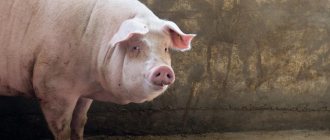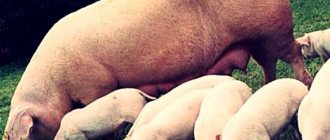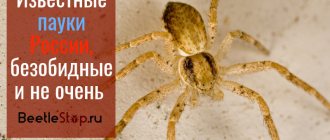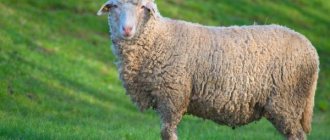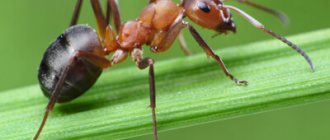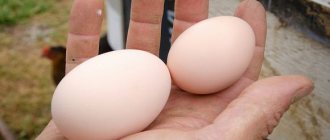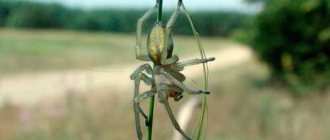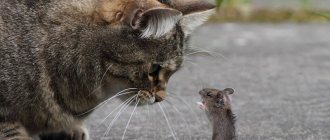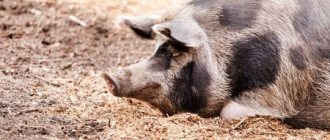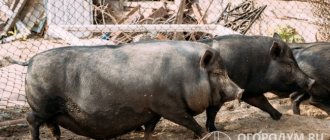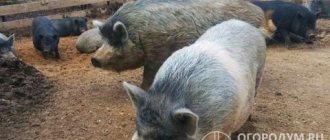Pigs are raised for both meat and lard. Accordingly, animals are distinguished between tallow, meat and meat-greasy breeds. They differ in the speed of weight gain and the nature of the gain: greasy pigs stop building muscle tissue at 6 months and continue to intensively form a fat layer.
There are many different sebaceous breeds. General characteristics are the volume of fat obtained from one carcass - up to 42%, high fertility, early maturity - 8-11 months, and exterior. Pigs in this category are omnivorous, unpretentious, usually not afraid of the cold and have a peaceful disposition.
Type Features
All breeds of pigs are divided into fat, meat and universal - meat and fat. The first are grown for the production of fatty meat and lard, the second for maximum meat yield, and the third have average characteristics. This article will tell you about the Ukrainian pig breed.
Today, most consumers prefer pork with minimal fat content. Because of this, meat (bacon) pig breeds have become much more popular. However, specialized farms still raise tallow animals.
The main difference between this breed is its high fat content. This kind of meat is obtained due to a feature inherent in all greasy pigs: they have a very short period of muscle tissue growth. Fat deposition begins much earlier than in representatives of meat breeds and it accumulates much more actively. This is especially noticeable when the animal reaches a large weight - more than 100 kg.
Breeds of tallow type pigs.
The external characteristics of a tallow pig are as follows:
- large head with large cheeks and ears. The neck is thick but short;
- The chest and back are very massive. Pigs of these breeds reach the largest sizes;
- the body of the animal is large, usually the volume of the chest is equal to or even exceeds the length of the body;
- large thick hams stand out;
- the legs are short but strong.
Tallow breeds are distinguished by early maturity, that is, very rapid growth and weight gain - animals gain 100 kg in 6-7 months, omnivorousness and high fertility - up to 12 piglets. The slaughter yield reaches 42% fat and approximately 50% meat.
The greasy type breeds differ in that. that with a short period of muscle tissue growth, they deposit fat even faster.
Ukrainian steppe speckled
Ukrainian Steppe Speckled
Breed was bred specifically for cultivation in the Ukrainian climate. It appeared in the Kherson region, in the process of crossing Berkshire, Mangalitsa, and Ukrainian steppe white breeds.
These tall breeds of pigs are large, have a powerful build, and are highly adaptable to heat and drought. They have a deep and fairly wide chest, a straight back, rounded, highly developed hams and a medium-sized hanging rump. The color is very diverse: from black with white spots to spotted black and red and spotted brown and white with various shades.
An adult boar can gain weight of more than 300-310 kg, and the length of its body reaches 180 cm. A sow weighs a little less - about 200-230 kg, with a body length of 150-160 cm. She is distinguished by good prolificacy.
In one farrow, a pig can produce up to 14 piglets. In babies, the average daily weight gain is 700 grams. By 6-7 months, they reach a weight of 100 kg. Ukrainian Steppe Speckled is a fairly popular breed among farmers. But it is grown mainly in Zaporozhye, Nikolaev, Kherson and Odessa regions of Ukraine.
Breeds
The cost of lard today is lower than the price of pork meat, so raising such breeds is considered unprofitable. In fact, in regions where the consumption of lard remains popular, they prefer to raise tallow or meat-tallow animals. Find out about the Hungarian Mangalica pig breed here.
Basic sebaceous breeds can be “translated” into the category of universal ones if you change the diet and increase the load on the muscles of the animals.
Breitovskaya
Strictly speaking, these animals belong to the meat-fat breeds, that is, when fat accumulates, the growth of muscle tissue does not stop, so both lard and tasty, not too fatty meat appear. However, a distinctive feature of the Breit breed is the large size of the animal, which allows it to be considered the best among both sebaceous and universal breeds.
The main advantage of the Breit breed is the high productivity of the animal, as well as excellent adaptation abilities to cold and sudden temperature changes. Pigs rarely get sick and tolerate winter well.
The external appearance of the Breitovskaya is impressive: these are very large animals with a proportional head, a muscular body with pronounced hams, and straight short legs. The neck is well defined, the head has a curved profile, large ears hang over the eyes. The skin is covered with dense white bristles; spotting is very rare.
An adult male is a boar, weighs up to 330 kg, a sow – 240 kg. In 7 months, piglets gain more than a hundred kg: with proper nutrition, the daily gain is 680 g. For 1 farrow, a pig gives 11–12 piglets, very rarely – 13–14. However, on average, every 2 sows give birth to piglets twice a year.
The meat of animals with medium fat content is very tender, the lard is white and dense. This link will tell you about Pietrain breed pigs.
The animals have a calm, peaceful disposition: they do not chew partitions, do not overturn stalls, do not rush at people, and care for their offspring very carefully. During the warm season, you can keep pigs outside in special facilities. During the cold season, animals are moved indoors.
Breitov pigs have very tender meat and dense lard.
Belarusian white
The Belarusian White is perhaps the most popular breed in Russia. It serves as the basis for many breeding experiments with the aim of producing tallow and meat breeds. The Belarusian white belongs to the meat and fat category of animals.
A large white pig has an unusual body structure: long - in males up to 2 m, in sows up to 1.7 m, wide, the back is arched and the transition to the lower back is hardly noticeable. The head is characterized by a non-standard shape - it is small and graceful with correct proportions, a small snout, the neck is long and thick. The animal's ears are large, but not drooping, but directed forward and upward. The skin is covered with white soft bristles; folds do not form even with great weight.
Boars of this breed reach 400 kg, and sows - 270 kg. With sufficient nutrition, a 2-month-old pig can weigh 25 kg, and a 6-month-old pig can weigh 100 kg. The sow gives birth to up to 12 piglets in one litter and feeds them completely independently.
Pigs are omnivores and quickly get used to bulk feed. However, with an incorrect diet - an excess of cereals, the risk of obesity and the transformation of the animal into a purely greasy pig greatly increases. Animals are distinguished by a peaceful disposition, even phlegmatic, so this phenomenon is not uncommon.
Animals of this breed are afraid of frost. Pigs should be kept in a room with insulated walls and ceiling.
Berkshire
The breed got its name from the county of Berkshire, where it appeared. Berkshire genes are actively used by breeders: the breed became the ancestor of the Mirgorod, North Caucasus, Liven and other famous breeds.
The main advantage of Berkshire pigs is the ability to quickly gain weight in the shortest possible time, combined with high meat quality.
Conventionally, the Berkshire breed is considered universal. In fact, whether an animal belongs to the category of lard or meat pigs is determined by the method of fattening - for meat and for lard.
Berkshire pigs have an elongated, voluminous body with a wide back and strong short legs. The head is large, but proportional, the ears are erect - forward and upward. The skin is covered with thick black bristles, and there are white spots on the tips of the tail, head and legs. The appearance of spots in other areas indicates a crossbreed.
An adult male weighs 300–350 kg, a female weighs 220–240 kg. Fertility is average - 6, maximum 9 piglets. Young animals gain weight very quickly - up to 750 g per day, and by 6 months they reach 100 kg.
Animals tolerate temperature changes well: in summer they can be grazed and kept in fences. In winter, pigs are moved to regular indoor spaces. Berkshires are most often raised for breeding purposes. Thus, when crossing a Berkshire boar and a Yorkshire sow, for example, a large number of piglets with improved taste of meat and lard are born.
With intensive feeding, the carcass weight increases by an average of 700-750 g per day.
Large black
The breed was developed in England by crossing Chinese and Neapolitan pigs with English long-eared pigs. The exterior is quite common for animals of sebaceous breeds: a large body with a wide barrel-shaped sternum and back, a large head and proportional in size, large and overhanging ears. The legs are short but strong, with well-defined legs. The body is covered with thick black fur without markings. A characteristic feature is the sagging of the sacrum, which causes the formation of numerous deep folds.
An adult boar can reach a weight of up to 380 kg, and a sow – up to 255 kg. Pigs are very fertile: the minimum number of piglets is 11, often up to 15 piglets appear. They grow very quickly: in 10 months they can gain weight up to 200 kg.
The versatility of the black breed lies not only in the fact that large black pigs are raised for meat and fat production, they are also used for breeding work.
Depending on the type of food, you can grow both large black meat - up to 52% meat - and lard.
Large black breed pigs are omnivorous, adapt well to a variety of climatic conditions, and tolerate both heat and cold well. In summer, animals can be grazed, but in winter they are kept indoors. This material will tell you how long pigs live at home.
Meishan
Of all the tallow breeds, Meishan is the oldest. It got its name from the name of the Chinese province. Later, Meishan spread throughout Asia and was exported to America and Europe.
The appearance of pigs is very memorable: the body is very massive, thick, with a wide chest and short legs. The skull is short, small compared to the length of the body, the ears are very long and almost completely cover the eyes. The main distinguishing feature is wrinkled, folded skin covered with black stubble. There are folds on the muzzle even around the eyes and nickel. European and American pigs may have white markings.
The differences between Meishan pigs and other species are their completely black body color, very long ears, large size and short head.
The fertility of Meishan is simply fantastic. The sow gives birth to piglets twice a year and up to 15–16 piglets are born in one litter. After only 3 months, the gilts have developed enough to continue conception and reproduction.
Meishan is a pure tallow breed. If 100 kg by 6 months is considered an excellent indicator, then a pig of this breed reaches 170 kg by 8 months. The volume of lard is 42–45%. The thickness of the subcutaneous fat is 3.5 cm. Another feature is the large internal organs. The fact is that in China, it is the lard and offal - liver, kidneys and lungs - that are valued in pigs, so breeders try to breed animals that are as fat as possible.
Prospects for lard production and its demand
Prospects for lard production
On world markets, the demand for lard and tallow pigs is slightly lower than for bacon or meat products. This is due to several reasons:
- there is a great need for pork meat (bacon) in cooking: many famous and popular dishes are prepared from pork meat;
- high costs for fattening tallow pigs;
- lower price compared to meat products.
However, raising tallow pigs is much easier.
All animals are picky in their diet, have an easy-going nature, and are easy to train. The gestation period for sows is slightly shorter (110-114 days), and they are characterized by multiple births.
In addition to using lard in natural or processed (dried, smoked, salted) form, it is part of cooking fat. Some types of lard are used in the pharmaceutical and cosmetic industries and are used as a technical lubricant.
Food industry experts count almost 22 breeds of pigs that are currently raised in large complexes and individual farms in the country. A significant share falls on meat-fat (universal) and tallow breeds of pigs on Russian farms.
Suffice it to say that the most common breed that can be found on Russian farms is the large white. Individuals of this meat-and-fat type breed are distinguished by a good immune system that allows them to adapt to any climatic conditions. Animals are bred both in the Krasnodar region and in Siberia.
Well, you have learned all the basic information about tallow breeds of pigs.
Also read: How is pig insemination done?
Features of piglets
Raising animals requires daily care, and tallow pigs are no exception. Representatives of different breeds can gain from 500 to 780 g per day. However, such record figures are only possible if a number of conditions are met. Read about farrowing pigs here.
If all the rules for growing tallow breeds are followed, piglets weigh 100 kg by 7 months.
The main difference between tallow piglets is the short period of muscle tissue gain - 6 months. After this, only adipose tissue is formed if the correct feeding conditions are met.
Piglets of most meat and lard breeds gain more than 100 kg by 6–7 months. This weight can be considered a turning point: if after this the animal continues to grow due to muscles, then it is a representative of the meat breed, if due to the accumulation of fat, it is a sebaceous breed.
In addition to feeding, other care rules must be followed:
- The sow feeds the piglets for 1.5 months. If there are a lot of young animals, it is necessary to supplement the piglets artificially - with a milk mixture with wheat;
- Animals should be kept in a closed but well-ventilated area. Drafts must be excluded: young animals do not tolerate colds well;
- It is very important to adhere to biorhythms, especially in winter. If the daylight hours are not long enough, piglets become weak, lose their appetite and stop growing. The pigsty must have artificial lighting;
- The sow and cubs must have a separate riser. After finishing milk feeding, the young animals are transferred to stalls;
- if it is intended to breed piglets, the pigsty must include an area for walking animals;
- For comfortable accommodation of pigs, bedding is needed. Traditionally, straw and sawdust are used for this. The material has good thermal insulation properties and is quite hygroscopic. The downside of this option is the smell and the need for daily tedious cleaning. For piglets, it is recommended to use fermentation bedding - material impregnated with lactic acid bacteria. For adult animals, a plastic slatted floor with manure baths placed underneath may be suitable.
With proper care and maintenance of pigs, you can get high quality lard.
Who to give preference to and why
When selecting a breed to obtain a high meat yield, you should pay attention not only to quantitative characteristics, but also to quality requirements for care and maintenance.
Requirements, first of all, must be correlated with your capabilities. High rates of increase in meat mass guarantee a large profit, but it should be understood that such breeds are very demanding in maintenance.
In addition, problems may arise with the health of pigs, bearing and feeding piglets.
Pietern sows are physically unable to feed 2-3 piglets from a litter. This means that fattening activities will have to be carried out by the breeder.
You should take into account the size of your own farm and financial capabilities. Having free circulation of finances for breeders will allow them to buy better and richer feeds, automate the feeding process and ultimately reduce the time required for fattening.
The Landrace breed requires heating in the pigsty, but the Vietnamese or Brazier breed is resistant to cold thanks to its thick coat.
But the main thing you need to pay attention to when breeding breeds for meat is the quality of the meat and its competitiveness in the markets.
Feeding
Proper fattening of tallow piglets is of decisive importance and it is not even a matter of how quickly the young animals will gain weight and how much weight they can achieve. The fact is that with an incorrect diet and free movement of animals, fat simply will not be formed in the required quantity, and the greasy pig will turn into a meat pig and not too fattened.
Fattening tallow pigs requires a large amount of carbohydrates in the diet. Corn concentrates and wheat are added to the piglets' feed. For older young animals, barley, potatoes or millet are used.
Pigs are omnivores. However, this does not mean that the livestock is fed only waste. A balanced diet should include:
- 50–60% green feed;
- 10% juicy;
- 5% herbal flour;
- 25–35% animal products.
Only with proper organization of the diet and daily routine can pigs be fattened to the desired condition, and in the shortest possible time.
Existing areas of pig fattening
It is best to start fattening pigs in spring or summer. Since the pig stomach does not digest whole grains well, it is better to grind grain products. It is advisable to give food to piglets not hot, but warm. Lunch uneaten by the babies is not left, but thrown away and the next feeding is carried out with fresh food.
It is undesirable for the diet to be based on foods with a high liquid content (mainly vegetables), since they contain a low percentage of proteins, which inhibits weight gain. To compensate for the lack of amino acids, the menu should include soy, fish meal, barley, chalk and other products containing calcium. When adding 30-35 g of salt to food, food is better absorbed. In addition, you need to ensure that your diet includes vitamins and minerals.
Important! The animals are fed twice a day. It is necessary to ensure that there is always fresh water in the drinking bowl.
conclusions
- Tallow breeds differ from meat breeds (Duroc, Karmaly) in the content of fat and meat: up to 42% fat.
- Pigs of this category are characterized by high fertility - from 9 to 15 piglets in each litter. With a different diet, a greasy pig, and even more so a meat-greasy breed, can turn into a meat pig.
- Animals are omnivorous and unpretentious. However, to achieve the desired condition, their diet must include a lot of carbohydrates: cereals, root vegetables, potatoes.
- Each tallow breed has its own advantages and disadvantages: boars of the Belarusian white breed reach 400 kg, but are afraid of cold weather. Meishan are exceptionally fertile and grow quickly, but are susceptible to disease.
Downy mangalica from Hungary
The Hungarian breed of pigs is characterized by a high content of fat in the carcass. As the name suggests, the breed was developed in Hungary in the 19th century. The livestock were kept free-range, like sheep, and from afar, downy pigs were often mistaken for sheep because of their long, thick and curly hair. The new breed was obtained by crossing domestic and wild pigs, so it was adapted to harsh weather conditions and grew well on pasture. For 70 years, barbecues were in demand, but by the beginning of the last century, a new trend had formed - meat and bacon types of pigs appeared, which consumers began to give preference to.
The downy mangalitsa was no longer grown on farms, the livestock went wild and scattered throughout the surrounding area, but in the 90s, Hungarian breeders managed to catch the last representatives of the breed in the amount of 200 animals and begin breeding them.
Today, Mangalitsa products are used to prepare such a delicacy as jamon.
Therefore, the number of representatives of the breed is growing year after year. But the live weight of a pig can only be sold on the territory of Hungary: the export of barbecues is prohibited. Outwardly, it would be difficult to distinguish Mangals from other breeds. But the characteristic features allow one to recognize the Mangalitsa at first glance: thick, long and curly hair and a Wellman's spot on the lower edge of the ear.
